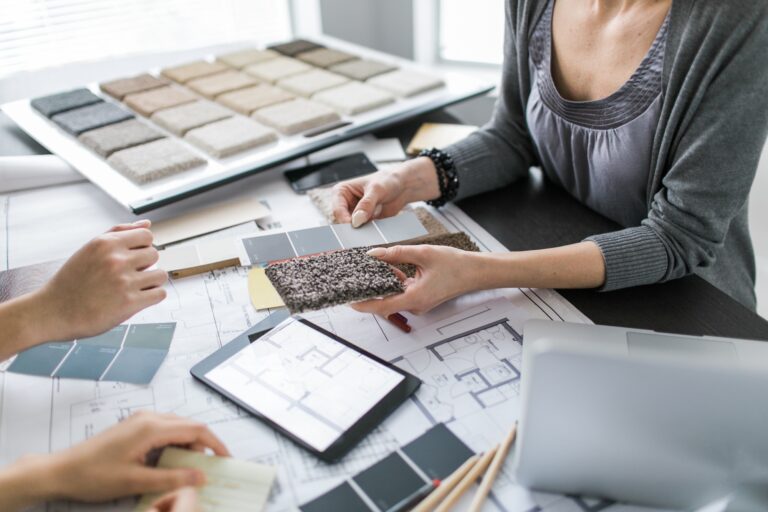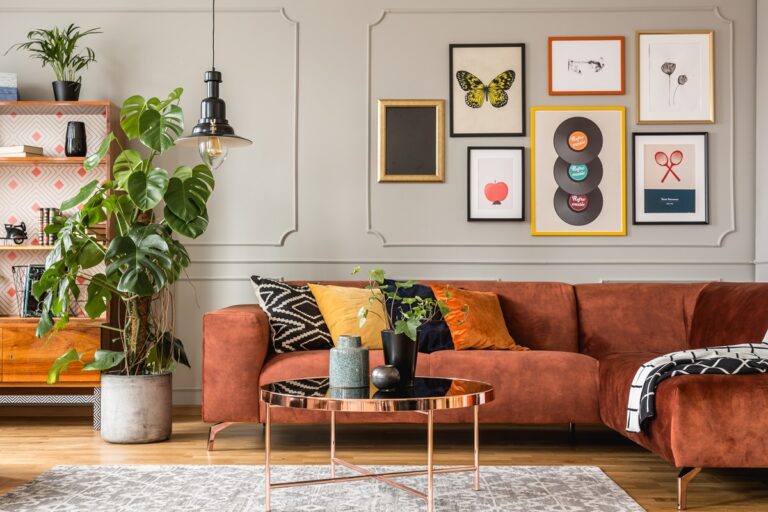Interior design projects involve so much more than choosing fabrics, furnishings, and finishes. Bringing your client’s vision to life not only requires creativity and artistic skill, but also rigorous organization, communication, and an ability to adhere to strict budgets and timelines.
This means that from the initial client consultation all the way through to the final installation, you’re likely going to be juggling several moving parts (think: clients, contractors, suppliers, sourcing, procurement..and much more!). Every interior design business owner must wear many different hats—including Project Manager—in order to ensure all the moving parts of their projects come together efficiently and successfully.
In this post, we’ll delve into all aspects of the interior design project management process. We’ll explore each of the various phases, from conception to completion, and offer our best project management tips.
Let’s dive in!
Table of Contents
7 Phases in the Interior Design Project Management Process
While the steps of every project will vary, depending on scope and resources, the average interior design project management process is comprised of 7 distinct phases, each crucial for the project’s progression. Using a typical full-scale interior design project, involving an element of construction, as our example, we’ll explore each phase in detail:
1. Pre-Design Phase
This initial phase lays the foundation for the entire project. It kicks off the design process, and involves gathering information, establishing project goals, and understanding the client’s needs and preferences. Key activities in this phase include:
- Client Consultation: Meeting with the client to discuss their objectives, budget, timeline, and aesthetic preferences.
- Site Assessment: Conducting a thorough evaluation of the space, considering its size, layout, architectural features, and any constraints.
- Research and Analysis: Gathering inspiration, researching trends, and analyzing the project’s feasibility based on budget and scope.
2. Conceptual Design Phase
Once the pre-design phase is complete, the conceptual design phase begins, where design concepts are developed and refined. This phase involves:
- Schematic Design: Creating preliminary design concepts that reflect the client’s vision and requirements. This may include floor plans, sketches, and mood boards.
- Design Development: Refining the chosen concept based on client feedback and incorporating more detailed elements such as material selections, color schemes, and furniture styles.
- Presentation: Presenting the finalized design concept to the client for approval, often accompanied by visual aids such as 3D renderings or virtual reality walkthroughs.
3. Design Development Phase
With the design concept approved, the focus shifts to developing detailed drawings and specifications necessary for construction and implementation. This phase includes:
- Technical Drawings: Creating detailed floor plans, elevations, and construction drawings that provide precise measurements and specifications for contractors and tradespeople.
- Material Selection: Finalizing material choices for finishes, furnishings, fixtures, and equipment, considering factors such as durability, aesthetics, and budget.
- Budget Refinement: Reviewing the project budget and making any necessary adjustments based on finalized design decisions.
This phase may involve many rounds of revisions and adjustments, as you work toward aligning your client’s vision and desire for quality with their budget. You might have to do some juggling here. For example, in order to accommodate that show-stopping chandelier in the living room, you might have to come up with a less expensive, yet still high quality, cabinet design for the kitchen.
4. Documentation and Permitting Phase
This phase is for any projects requiring construction. Here, the project documentation is prepared and submitted for regulatory approvals and required permits. Key tasks include:
- Documentation Compilation: Organizing all project documents, including drawings, specifications, and permit applications, into a comprehensive package for review.
- Regulatory Compliance: Ensuring that the design complies with building codes, zoning regulations, and other legal requirements.
- Permit Acquisition: Submitting permit applications and supporting documents to the relevant authorities and obtaining approvals to proceed with construction.
5. Sourcing and Procurement Phase
Once approvals are obtained, the focus shifts to sourcing and procuring materials, furnishings, and equipment needed for the project. This phase involves:
- Vendor Selection: Identifying and selecting suppliers, manufacturers, and vendors based on quality, price, and lead times.
- Order Placement: Placing orders for materials, furniture, fixtures, and equipment according to project specifications and timelines.
- Logistics Coordination: Managing the logistics of delivery, storage, and installation to ensure that materials arrive on time and in good condition.
6. Construction and Implementation Phase
With all necessary approvals and materials in place, the project moves into the construction and implementation stage. This phase includes:
- Contractor Management: Overseeing construction activities, coordinating subcontractors, and ensuring that work is completed according to specifications and schedules.
- Quality Control: Conducting regular site inspections to monitor workmanship and address any issues or deviations from the design.
- Client Communication: Keeping the client informed of progress, addressing any concerns or changes, and managing expectations throughout the construction process. We recommend sending a weekly update email.
7. Finalization and Handover Phase
As the project nears completion, the focus shifts to finalizing details, conducting inspections, and preparing for client handover. Key activities include:
- Punch List: Creating a punch list of remaining tasks and deficiencies to be addressed before final acceptance.
- Installation and Styling: Overseeing the installation of furnishings, accessories, and artwork, and styling the space to achieve the desired aesthetic.
- Client Orientation: Conducting a walkthrough with the client to familiarize them with the completed project, explain systems and features, and address any questions or concerns.
10 Tips to Better Manage Interior Design Projects
Managing interior design projects effectively requires attention to detail, strong communication skills, and the ability to adapt to changing circumstances. Here are 10 tips to help you navigate the interior design project management process with clarity and confidence:
1. Establish Clear Communication Channels
Effective communication is essential for keeping clients, team members, and vendors informed and aligned throughout the project. Maintain regular check-ins, use design project management software (like DesignFiles), and establish protocols for addressing issues and changes in a timely way.
In our experience, lack of adequate communication is one of the leading causes of problems during an interior design project. This is why it’s especially crucial to make sure all stakeholders are always aligned on project goals, project schedules, and project costs.
2. Set Realistic Expectations
Ensure that clients have a clear understanding of what to expect regarding timelines, budget, and project scope from the outset. Be transparent about potential challenges and constraints and provide regular updates to manage expectations effectively.
3. Create Detailed Project Plans
Develop comprehensive project plans that outline key milestones, tasks, and deadlines to keep the project on track. Break down larger tasks into smaller, actionable steps and allocate resources accordingly to avoid delays and bottlenecks.
4. Foster Collaboration and Teamwork
Encourage collaboration among team members, including designers, contractors, and suppliers, to leverage their expertise and ensure a cohesive approach to project execution. Foster a culture of teamwork and mutual respect to promote a healthy and enjoyable working environment.
5. Prioritize Quality Assurance
Implement robust quality control measures throughout the project lifecycle to ensure that work meets the required standards and specifications. Conduct regular inspections, address any issues promptly, and strive for continuous improvement in processes and outcomes.
6. Stay Flexible and Adaptive
Be prepared to adapt to changes and unforeseen circumstances that may arise during the project, such as design revisions, material shortages, or construction delays. Maintain a flexible mindset, explore alternative solutions, and communicate proactively to mitigate risks and minimize disruptions.
7. Manage Budgets Wisely
Track project expenses closely and monitor budget allocations to prevent cost overruns and ensure financial viability. Prioritize spending based on project priorities, seek cost-effective solutions where possible, and negotiate favorable terms with suppliers and contractors to maximize value.
8. Embrace Technology Tools
Take advantage of technology tools and software solutions designed for project management, scheduling, and collaboration to streamline workflows and enhance productivity. DesignFiles, for example, offers all-inclusive project management software, which supports you through every step of the interior design project management process, from creating moodboards and communicating with clients to sourcing items and tracking orders.
9. Cultivate Client Relationships
Nurture positive relationships with clients by demonstrating professionalism, responsiveness, and a commitment to their satisfaction. Listen actively to their feedback, address concerns promptly, and strive to exceed their expectations to build trust and loyalty. By investing in building a strong connection with your clients, you’ll not only make the process more enjoyable, you’ll also increase the chances of being hired again for future projects.
10. Learn from Each Project
Reflect on each project upon completion to identify lessons learned, successes, and areas for improvement. Use this feedback to refine your project management processes, enhance skills, and deliver even better outcomes for future projects.
Conclusion
Effective project management is critical for the successful execution of interior design projects, from conception to completion. By following a structured approach and implementing best practices, you can streamline workflows, mitigate risks, and deliver exceptional results that exceed client expectations.
The more repeatable systems and processes you can put into place (software is a HUGE help with this), the easier the interior design project management process becomes. Especially if you’re juggling multiple projects at once, or working in different areas, such as residential and commercial, getting your project management process down to a science will make your life—and running your business—a lot easier.
Whether you’re a seasoned professional or embarking on your first project, applying these principles can help you navigate the complexities of interior design project management with confidence and success.
DesignFiles offers an easy-to-use platform with all of the client and project management tools you need in one place. Sign up for your free trial.
 Miranda E
Miranda E


